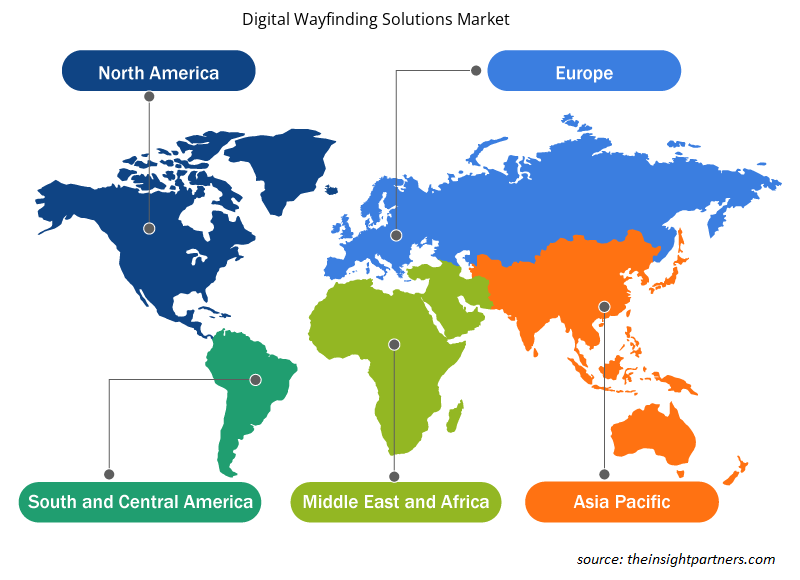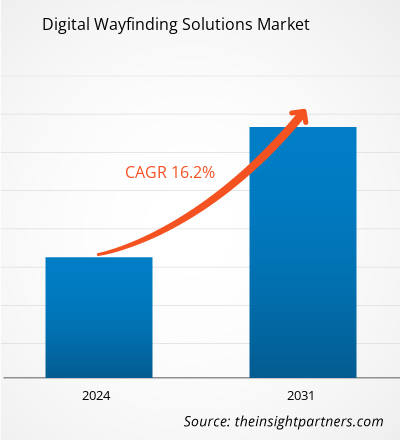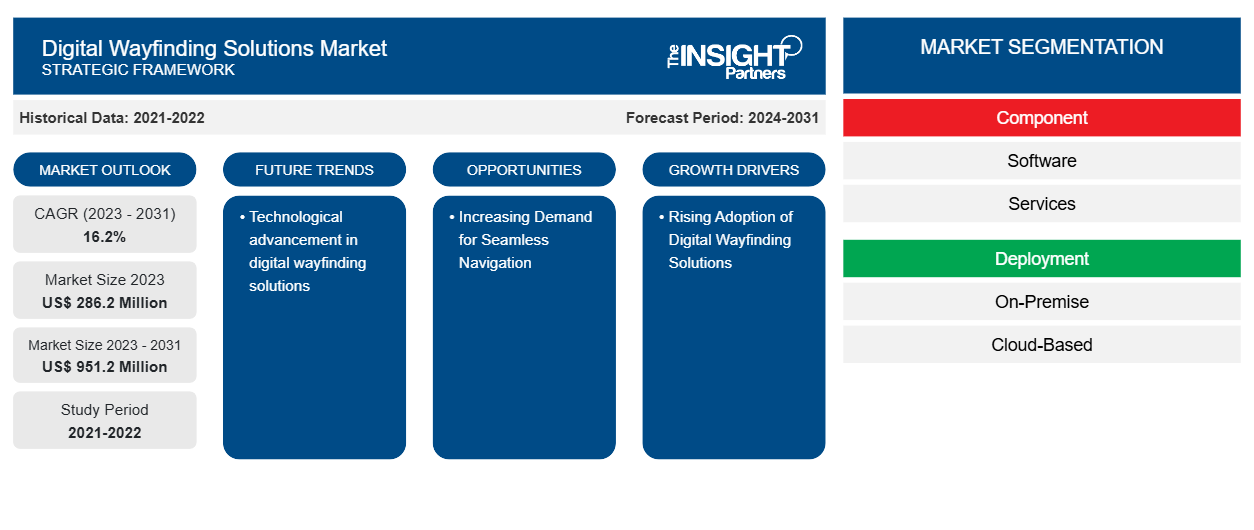Si prevede che la dimensione del mercato delle soluzioni di digital wayfinding raggiungerà i 951,2 milioni di dollari entro il 2031, rispetto ai 286,2 milioni di dollari del 2023. Si prevede che il mercato registrerà un CAGR del 16,2% nel periodo 2023-2031. È probabile che il progresso tecnologico nelle soluzioni di digital wayfinding rimanga una tendenza chiave nel mercato.
Analisi di mercato delle soluzioni di orientamento digitaleWayfinding Solutions Market Analysis
I wayfinder digitali forniscono alle aziende eccellenti analisi e approfondimenti sui dati. Questi dati includono informazioni su orari di punta, percorsi popolari e visite frequenti alle aree. In un centro commerciale, il sistema può tracciare il traffico pedonale per individuare aree ad alto traffico, consentendo alle aziende di posizionare strategicamente espositori promozionali o ottimizzare i layout dei negozi per aumentare la visibilità e le vendite. Inoltre, il monitoraggio del comportamento degli utenti nei sistemi di wayfinding digitali facilita le aziende nel comprendere come gli individui interagiscono con il sistema. In un ambiente museale, il monitoraggio delle preferenze degli utenti per le visite alle mostre può informare i visitatori sulle loro preferenze. Queste informazioni aiutano i curatori a creare mostre future per integrare argomenti popolari e migliorare l'esperienza dei visitatori.
Panoramica del mercato delle soluzioni di orientamento digitaleWayfinding Solutions Market Overview
Il wayfinding digitale utilizza tecnologie come mappe interattive, touch screen e app mobili per guidare gli individui nella scoperta del loro percorso in ambienti interni o esterni. Ha notevolmente migliorato i metodi di ricerca tradizionali utilizzando la tecnologia per fornire soluzioni di navigazione in tempo reale, dinamiche e personalizzate. A differenza della segnaletica statica , gli schermi digitali forniscono informazioni aggiornate in tempo reale, consentendo agli utenti di accedere alle indicazioni più accurate e precise. L'aeroporto utilizza sistemi avanzati di wayfinding digitale per fornire una navigazione fluida ai passeggeri attraverso terminal, gate e strutture. Nonostante sia uno degli aeroporti più affollati al mondo, l'adozione di questi sistemi all'avanguardia mira a migliorare la comunicazione complessiva e l'efficienza operativa.
Personalizza questo report in base alle tue esigenze
Riceverai la personalizzazione gratuita di qualsiasi report, comprese parti di questo report, o analisi a livello nazionale, pacchetto dati Excel, oltre a usufruire di grandi offerte e sconti per start-up e università
-
Scopri le principali tendenze di mercato in questo rapporto.Questo campione GRATUITO includerà analisi di dati che spaziano dalle tendenze di mercato alle stime e alle previsioni.
Driver di mercato e opportunità per le soluzioni di orientamento digitale
Crescente adozione di soluzioni di orientamento digitale per favorire il mercato
Le soluzioni di segnaletica digitale hanno una vasta gamma di casi d'uso comuni in vari settori e ambienti. Alcuni dei casi d'uso più diffusi includono: aeroporti, centri commerciali, ospedali e strutture sanitarie, istituti scolastici , istituti scolastici, centri espositivi e congressuali, musei e istituzioni culturali e molti altri. Gli aeroporti utilizzano soluzioni di segnaletica digitale per aiutare i viaggiatori a orientarsi nei terminal, trovare i gate, individuare le aree di ritiro bagagli e accedere ai servizi aeroportuali. Queste soluzioni spesso includono informazioni sui voli in tempo reale, tempi di attesa ai controlli di sicurezza e informazioni su servizi come ristoranti e negozi. Le soluzioni di segnaletica digitale forniscono informazioni sul comportamento degli utenti, come percorsi popolari, aree visitate di frequente e modelli di navigazione. Questi dati possono essere analizzati per ottenere informazioni sulle preferenze degli utenti, sul flusso del traffico e sull'utilizzo complessivo delle strutture, consentendo alle organizzazioni di prendere decisioni basate sui dati e ottimizzare i propri spazi.wayfinding solutions have a wide range of common use cases in various industries and environments. Some of the most prevalent use cases include: airports, shopping malls, hospitals and healthcare facilities, wayfinding solutions to help travelers navigate terminals, find their gates, locate baggage claim areas, and access airport amenities. These solutions often include real-time flight information, security checkpoint wait times, and information on services like restaurants and shops. Digital wayfinding solutions provide information on user behavior, such as popular routes, frequently visited areas, and navigation patterns. This data can be analyzed to gain insights into user preferences, traffic flow, and overall facility usage, enabling organizations to make data-driven decisions and optimize their spaces.
Crescente domanda di navigazione senza interruzioni
La segnaletica digitale offre una navigazione senza sforzo, indicazioni chiare e un modo comodo per gli utenti di orientarsi in aeroporti, centri commerciali, ospedali e altro ancora. Una segnaletica chiara e concisa migliora l'esperienza complessiva dell'utente riducendo stress, frustrazione e confusione. Che si tratti di muoversi in una stazione ferroviaria affollata o in un campus aziendale tentacolare, i sistemi di segnaletica intuitivi offrono tranquillità e sicurezza sia ai visitatori che ai dipendenti. È difficile orientarsi in un centro commerciale tentacolare, ma le mappe interne possono semplificare il processo. Gli acquirenti possono facilmente individuare i negozi desiderati, trovare servizi come bagni e scale mobili e tracciare il percorso più breve per raggiungere le loro destinazioni. Che si tratti di un visitatore per la prima volta o di un visitatore abituale, le mappe interne offrono un viaggio fluido e senza stress attraverso l'intricato layout del centro commerciale. Con l'evoluzione della tecnologia, l'integrazione di soluzioni di segnaletica digitale e display interattivi migliorerà ulteriormente le capacità e l'efficacia dei sistemi di segnaletica di segnaletica, inaugurando una nuova era di navigazione fluida per tutti.wayfinding provides effortless navigation, clear directions, and a convenient way for users to navigate airports, shopping malls, hospitals, and more.Clear and concise wayfinding enhances the overall user experience by reducing stress, frustration, and confusion. Whether navigating a busy train station or a sprawling corporate campus, intuitive signage systems provide peace of mind and confidence to visitors and employees alike. It's difficult to navigate a sprawling shopping mall, but indoor maps can simplify the process. Shoppers can easily locate their desired stores, locate amenities such as bathrooms and escalators, and chart the shortest route to their destinations. Whether it's a first-time visitor or a regular visitor, indoor maps provide a seamless and stress-free journey throughout the mall's intricate layout. As technology evolves, incorporating digital wayfinding solutions and interactive displays will further enhance the capabilities and effectiveness of wayfinding signage systems, ushering in a new era of seamless navigation for all.
Analisi della segmentazione del rapporto di mercato sulle soluzioni di orientamento digitaleWayfinding Solutions Market Report Segmentation Analysis
I segmenti chiave che hanno contribuito alla derivazione dell'analisi di mercato delle soluzioni di orientamento digitale sono i componenti, l'implementazione e l'utente finale.wayfinding solutions market analysis are component, deployment, and end user.
- In base ai componenti, il mercato delle soluzioni di orientamento digitale è segmentato in software e servizi.wayfinding solutions market is segmented into software and services.
- In base all'implementazione, il mercato è segmentato in on-premise e basato su cloud.
- In termini di applicazione, il mercato è segmentato in aeroporti, vendita al dettaglio, assistenza sanitaria, musei e altri.
Analisi della quota di mercato delle soluzioni di orientamento digitale per area geograficaWayfinding Solutions Market Share Analysis by Geography
L'ambito geografico del rapporto di mercato sulle soluzioni di digital wayfinding è suddiviso principalmente in cinque regioni: Nord America, Asia Pacifico, Europa, Medio Oriente e Africa e Sud e Centro America. La Cleveland Clinic è un centro medico degno di nota negli Stati Uniti che ha implementato un sistema ad alta tecnologia per assistere pazienti e visitatori nella navigazione del complesso campus. Questo sistema di digital wayfinding utilizza touchscreen interattivi e app mobili per fornire ai pazienti indicazioni passo dopo passo per cliniche, reparti e stanze dei pazienti.
Approfondimenti regionali sul mercato delle soluzioni di orientamento digitale
Le tendenze regionali e i fattori che influenzano il mercato delle soluzioni di orientamento digitale durante il periodo di previsione sono stati ampiamente spiegati dagli analisti di Insight Partners. Questa sezione discute anche i segmenti e la geografia del mercato delle soluzioni di orientamento digitale in Nord America, Europa, Asia Pacifico, Medio Oriente e Africa e America meridionale e centrale.

- Ottieni i dati specifici regionali per il mercato delle soluzioni di orientamento digitale
Ambito del rapporto di mercato sulle soluzioni di orientamento digitale
| Attributo del report | Dettagli |
|---|---|
| Dimensioni del mercato nel 2023 | 286,2 milioni di dollari USA |
| Dimensioni del mercato entro il 2031 | 951,2 milioni di dollari USA |
| CAGR globale (2023-2031) | 16,2% |
| Dati storici | 2021-2022 |
| Periodo di previsione | 2024-2031 |
| Segmenti coperti |
Per componente
|
| Regioni e Paesi coperti |
America del Nord
|
| Leader di mercato e profili aziendali chiave |
|
Soluzioni di Digital Wayfinding Market Players Densità: comprendere il suo impatto sulle dinamiche aziendali
Il mercato delle soluzioni di Digital Wayfinding sta crescendo rapidamente, spinto dalla crescente domanda degli utenti finali dovuta a fattori quali l'evoluzione delle preferenze dei consumatori, i progressi tecnologici e una maggiore consapevolezza dei vantaggi del prodotto. Con l'aumento della domanda, le aziende stanno ampliando le loro offerte, innovando per soddisfare le esigenze dei consumatori e capitalizzando sulle tendenze emergenti, il che alimenta ulteriormente la crescita del mercato.
La densità degli operatori di mercato si riferisce alla distribuzione di aziende o società che operano in un particolare mercato o settore. Indica quanti concorrenti (operatori di mercato) sono presenti in un dato spazio di mercato in relazione alle sue dimensioni o al valore di mercato totale.
Le principali aziende che operano nel mercato delle soluzioni di orientamento digitale sono:
- Acquisizione digitale
- Clicca su Grafix
- Segno Connesso
- SOLUZIONI DI WAYFINDING DIGITALE
- Tecnologie Jarma LLP
- MetroClicca
Disclaimer : le aziende elencate sopra non sono classificate secondo un ordine particolare.

- Ottieni una panoramica dei principali attori del mercato delle soluzioni di orientamento digitale
Notizie di mercato e sviluppi recenti sulle soluzioni di orientamento digitale
Il mercato delle soluzioni di digital wayfinding viene valutato raccogliendo dati qualitativi e quantitativi dopo la ricerca primaria e secondaria, che include importanti pubblicazioni aziendali, dati associativi e database. Di seguito sono elencati alcuni degli sviluppi nel mercato delle soluzioni di digital wayfinding:
- 22Miles Inc. ha annunciato oggi il lancio di Digital Signage Ready (DSR), una raccolta di pacchetti software e servizi pronti all'uso che semplificano la configurazione e l'implementazione delle esperienze di digital signage più diffuse. (Fonte: 22Miles Inc., luglio 2021)
- Acquire Digital ha lanciato una soluzione di directory e wayfinding digitale per la prossima fiera Grocery shop tradeshow. La piattaforma di navigazione indoor e wayfinding interattiva leader del settore di Acquire Digital verrà utilizzata per assistere i partecipanti nella navigazione della fiera, nell'esplorazione degli eventi e nella scoperta di altro materiale espositivo essenziale. (Fonte: Acquire Digital, settembre 2021)
Copertura e risultati del rapporto di mercato sulle soluzioni di orientamento digitale
Il rapporto "Dimensioni e previsioni del mercato delle soluzioni di orientamento digitale (2021-2031)" fornisce un'analisi dettagliata del mercato che copre le seguenti aree:
- Dimensioni e previsioni del mercato delle soluzioni di orientamento digitale a livello globale, regionale e nazionale per tutti i segmenti di mercato chiave coperti dall'ambito
- Tendenze del mercato delle soluzioni di orientamento digitale e dinamiche di mercato come conducenti, restrizioni e opportunità chiave
- Analisi dettagliata delle cinque forze PEST/Porter e SWOT
- Analisi di mercato delle soluzioni di orientamento digitale che copre le principali tendenze di mercato, il quadro globale e regionale, i principali attori, le normative e i recenti sviluppi del mercato
- Analisi del panorama industriale e della concorrenza che copre la concentrazione del mercato, l'analisi della mappa di calore, i principali attori e gli sviluppi recenti per il mercato delle soluzioni di orientamento digitale
- Profili aziendali dettagliati
- Analisi storica (2 anni), anno base, previsione (7 anni) con CAGR
- Analisi PEST e SWOT
- Valore/volume delle dimensioni del mercato - Globale, Regionale, Nazionale
- Industria e panorama competitivo
- Set di dati Excel
Report recenti
Rapporti correlati
Testimonianze
Motivo dell'acquisto
- Processo decisionale informato
- Comprensione delle dinamiche di mercato
- Analisi competitiva
- Analisi dei clienti
- Previsioni di mercato
- Mitigazione del rischio
- Pianificazione strategica
- Giustificazione degli investimenti
- Identificazione dei mercati emergenti
- Miglioramento delle strategie di marketing
- Aumento dell'efficienza operativa
- Allineamento alle tendenze normative























 Ottieni un campione gratuito per - Mercato delle soluzioni di orientamento digitale
Ottieni un campione gratuito per - Mercato delle soluzioni di orientamento digitale